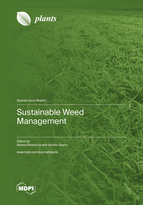Sustainable Weed Management
A special issue of Plants (ISSN 2223-7747). This special issue belongs to the section "Plant Protection and Biotic Interactions".
Deadline for manuscript submissions: closed (15 March 2022) | Viewed by 48599
Special Issue Editors
Interests: weeds; soil seedbank; germination ecology; allelopathy; biocontrol; natural compound; environmental and applied botany
Special Issues, Collections and Topics in MDPI journals
Interests: agronomy; crop production; allelopathy; weed science; weed management; cover crops; fertilization; Cynara cardunculus; potato
Special Issues, Collections and Topics in MDPI journals
Special Issue Information
Dear Colleagues,
The environmental impact and the increasing phenomena of weed resistance caused by the irrational use of synthetic herbicides have led government institutions and public opinion to a growing interest in eco-friendly and sustainable tools for weed management. The scientific community is therefore called to further improve the efforts for the search of new environmentally-based and more efficient approaches.
This Special Issue will focus on the recent advancements in the wide field of sustainable weed management. Research papers, communications, and review articles are welcome. We invite you to share your contributions on the following topics (not an exhaustive list): 1) weed biology; 2) biotic and abiotic factors for plant adaptation strategies; 3) preventive or indirect methods (stale seedbed, crop rotation, increase of crop competitive capacity, etc.); 4) management of the soil seedbank; 5) cover cropping; 6) non-chemical weed control such as physical, mechanical, and biological methods; 7) use of allelopathic mechanisms for weed control (mulching, use of plant extracts as bioherbicides, intercropping, etc.); 8) application and development of weed thresholds. Particular attention will be given to integrated weed management in agroecosystems and studies involving botanical and ecological aspects (weed emergence models, floristic composition and species diversity, plant associations and ecosystem services).
Dr. Alessia RestucciaDr. Aurelio Scavo
Guest Editors
Manuscript Submission Information
Manuscripts should be submitted online at www.mdpi.com by registering and logging in to this website. Once you are registered, click here to go to the submission form. Manuscripts can be submitted until the deadline. All submissions that pass pre-check are peer-reviewed. Accepted papers will be published continuously in the journal (as soon as accepted) and will be listed together on the special issue website. Research articles, review articles as well as short communications are invited. For planned papers, a title and short abstract (about 100 words) can be sent to the Editorial Office for announcement on this website.
Submitted manuscripts should not have been published previously, nor be under consideration for publication elsewhere (except conference proceedings papers). All manuscripts are thoroughly refereed through a single-blind peer-review process. A guide for authors and other relevant information for submission of manuscripts is available on the Instructions for Authors page. Plants is an international peer-reviewed open access semimonthly journal published by MDPI.
Please visit the Instructions for Authors page before submitting a manuscript. The Article Processing Charge (APC) for publication in this open access journal is 2700 CHF (Swiss Francs). Submitted papers should be well formatted and use good English. Authors may use MDPI's English editing service prior to publication or during author revisions.
Keywords
- weed biology
- plants adaptation strategies
- integrated weed management
- cover crops
- allelopathy
- bioherbicides
- biological methods
- mechanical methods
- physical methods
- cultural methods
- soil seedbank
- weed thresholds
- floristic composition
- ecosystem services








